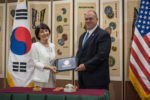 U.S. Immigration and Customs Enforcement (ICE) returned two looted royal seals from the Joseon Dynasty to the Republic of Korea at a ceremony held in Washington, D.C., on June 30th. The repatriation ceremony was planned to coincide with South Korean President Moon Jae-In’s visit to Washington so that Thomas D. Homan, acting director of ICE, could formally hand the seals over to the President who then carried them back to South Korea personally.
U.S. Immigration and Customs Enforcement (ICE) returned two looted royal seals from the Joseon Dynasty to the Republic of Korea at a ceremony held in Washington, D.C., on June 30th. The repatriation ceremony was planned to coincide with South Korean President Moon Jae-In’s visit to Washington so that Thomas D. Homan, acting director of ICE, could formally hand the seals over to the President who then carried them back to South Korea personally.
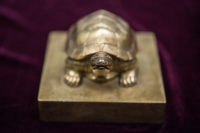 The two royal seals are the same size — four inches square — and both have handles shaped like turtles, but they were made a century apart from different materials. The oldest of them is the royal seal Queen Munjeong (1501-1565) which was made in 1547 out of gilt bronze. Technically 1547 was the second year of her son’s reign, but King Myeongjong was just 12 years old when he ascended the throne after his half-brother’s death under suspicious circumstances, so Queen Munjeong acted as regent. The seal uses a title given to Munjeong during her early regency.
The two royal seals are the same size — four inches square — and both have handles shaped like turtles, but they were made a century apart from different materials. The oldest of them is the royal seal Queen Munjeong (1501-1565) which was made in 1547 out of gilt bronze. Technically 1547 was the second year of her son’s reign, but King Myeongjong was just 12 years old when he ascended the throne after his half-brother’s death under suspicious circumstances, so Queen Munjeong acted as regent. The seal uses a title given to Munjeong during her early regency.
(It was widely believed that Myeongjong’s half-brother King Injong, who reigned for only one year after his father’s death and was 30 years old when he died, was poisoned to death. Queen Munjeong was the prime suspect for the ringleader of the conspiracy to remove the young, reform-minded, active king and replace him with his kid brother whom she could easily manipulate. She stayed on as regent long past her son’s majority, remaining queen until her death 20 years later. Myeongjong was 32 years old when he finally became king in more than name.)
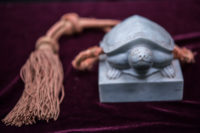 The second royal seal was made for the future King Hyeonjong (r. 1659-1674) to commemorate his becoming the crown prince in 1651. It’s carved out of highly prized white jade and is taller and more massive than the Queen’s seal.
The second royal seal was made for the future King Hyeonjong (r. 1659-1674) to commemorate his becoming the crown prince in 1651. It’s carved out of highly prized white jade and is taller and more massive than the Queen’s seal.
Both of these are of a type of royal seal known as an “eobo,” used for ceremonial purposes rather than for official government documents which were the province of the “guksae” or the great seal. Because they were the official stamp of royal authority, the production, deployment and retirement of royal seals were stringently regulated by the Jongmyo, the Confucian shrine dedicated to the preserving the memory and rituals of the Joseon royals. The Joseon Dynasty is one of the longest ruling dynasties in the history of the world (1392 to 1897), so you might be forgiven for thinking they were lousy with royal seals after all that time, but because of that strict oversight, during the 500+ years of the Joseon Kingdom and Korean Empire only 37 guksae and 375 eobo were made.
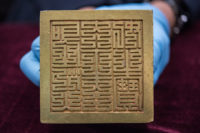 They were all present and accounted for until the Japanese occupation of Korea (1910-1945). The seals were hot items for looters and pillagers, and continued to be actively stolen during the Korean War (1950-53). The two returned seals are microcosms of the larger syndrome. Queen Munjeong’s seal is believed to have been stolen during the Korean War, King Hyeonjong’s during the Japanese occupation. The Korean government has vigorously pursued all leads to track down their precious cultural heritage since the 1950s. Four of the great seals have been recovered and seven of the royal seals. There are still 29 great state seals and 46 royal ones unaccounted for as of today.
They were all present and accounted for until the Japanese occupation of Korea (1910-1945). The seals were hot items for looters and pillagers, and continued to be actively stolen during the Korean War (1950-53). The two returned seals are microcosms of the larger syndrome. Queen Munjeong’s seal is believed to have been stolen during the Korean War, King Hyeonjong’s during the Japanese occupation. The Korean government has vigorously pursued all leads to track down their precious cultural heritage since the 1950s. Four of the great seals have been recovered and seven of the royal seals. There are still 29 great state seals and 46 royal ones unaccounted for as of today.
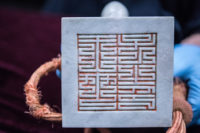 The seals are a microcosm of Korea’s assiduous attempts to reclaim their lost treasures too. There are US State Department records going back to the mid-1950s that document requests from the Korean ambassador to locate the stolen seals of Queen Munjeong and King Hyeonjong. There is no evidence of any investigation taking place at that time. That would have to wait until 2013 when ICE’s Homeland Security Investigations (HSI) division opened an investigation into Queen Munjeong’s royal seal at the request of South Korea’s Cultural Heritage Administration (CHA) who had found out the seal at the Los Angeles County Museum of Art (LACMA) and had been for 13 years. The Korean Broadcasting Service did a little digging and identified the private collector who sold the Queen’s seal to LACMA in 2000. They found the King’s seal at his house.
The seals are a microcosm of Korea’s assiduous attempts to reclaim their lost treasures too. There are US State Department records going back to the mid-1950s that document requests from the Korean ambassador to locate the stolen seals of Queen Munjeong and King Hyeonjong. There is no evidence of any investigation taking place at that time. That would have to wait until 2013 when ICE’s Homeland Security Investigations (HSI) division opened an investigation into Queen Munjeong’s royal seal at the request of South Korea’s Cultural Heritage Administration (CHA) who had found out the seal at the Los Angeles County Museum of Art (LACMA) and had been for 13 years. The Korean Broadcasting Service did a little digging and identified the private collector who sold the Queen’s seal to LACMA in 2000. They found the King’s seal at his house.
The seals will be conserved and stored at the National Palace Museum of Korea in Seoul. They won’t go on display right away. The CHA is currently planned a special exhibit in August that will put the royal seals on public view.
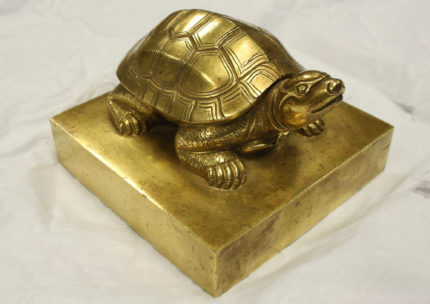
“Oppan Turtle Style !!!!”
:boogie: